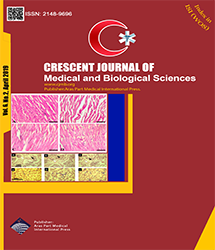
| Original Article | |
| Effect of Fish and Flaxseed Oil Supplementation on Isoprenaline-Induced Myocardial Infarction in Rats: Inhibition of Mitochondrial Permeability Transition Pore Opening | |
| Seyd Hosein Abtahi Ivary1, Najme Jajarmy1, Mehedi Karimi Shahri1, Majid Shokoohi2, Hamed Shoorei2, Abbas Ebadi3, Maryam Moghimian1, Faraz Sigaroodi2 | |
| 1Department of Basic Sciences, School of Medicine, Gonabad University of Medical Sciences, Gonabad, Iran 2Department of Anatomical Sciences, Faculty of Medicine, Tabriz University of Medical Sciences, Tabriz, Iran 3Department of Emergency Medicine, School of Medicine, Iran University of Medical Sciences, Tehran, Iran |
|
|
CJMB 2019; 6: 158-163 Viewed : 4395 times Downloaded : 3062 times. Keywords : Isoprenaline, Myocardial Infarction, Fish oil, Flaxseed oil, Cardioprotection |
|
| Full Text(PDF) | Related Articles | |
| Abstract | |
Objectives: Dietary n-3 polyunsaturated fatty acids have positive effects on the heart. The present study investigated the effects of pretreatment with fish oil (FO) and flaxseed oil (FLO) on the heart of the rat, which is associated with the isoprenaline (ISO)-induced myocardial injury. Materials and Methods: The study was conducted on 40 male Wistar rats which were included in control, ISO, FO + ISO, and FLO + ISO groups (each containing 10 rats). In ISO rats, acute myocardial ischemia was induced by ISO while in FO + ISO group, the rats were pretreated with FO orally for 4 weeks. Finally, rats in the FLO + ISO group received pretreatment with FO and flaxseed oil orally for 4 weeks. Eventually, the histopathological examinations of the cardiac tissues and serum activity of creatine kinase-MB (CK-MB) were assessed. Moreover, mitochondria were isolated to examine the mitochondrial swelling. Results: Based on the results, ISO administration significantly increased the serum CK-MB activity compared to the control group. In addition, severe muscular damage to the heart was observed in more than 70% of the rats in ISO group. However, a remarkable decrease in the intensity of heart tissue destruction, as well as the serum levels of CKMB was found in the FO + ISO group compared to the ISO group. Conversely, there was no significant decrease in the serum level of CKMB in FLO + ISO group compared to the ISO group. Conclusions: In general, pretreatment with FLO significantly suppressed the intensity of heart tissue destruction compared to the myocardial ischemic group. FO and FLO led to a decrease in CaCl2-induced swelling in the mitochondria. Therefore, FO and FLO result in protecting against ischemia/reperfusion injury through inhibiting the 1-methyl-4-phenyl-1,2,3,6-tetrahydropyridine. |
Cite By, Google Scholar
Google Scholar
PubMed
Online Submission System
 CJMB ENDNOTE ® Style
CJMB ENDNOTE ® Style
 Tutorials
Tutorials
 Publication Charge
Medical and Biological Research Center
About Journal
Publication Charge
Medical and Biological Research Center
About Journal
Aras Part Medical International Press Editor-in-Chief
Arash Khaki
Deputy Editor
Zafer Akan


















